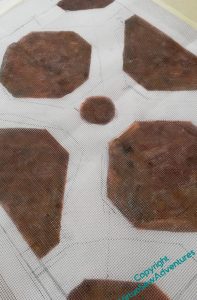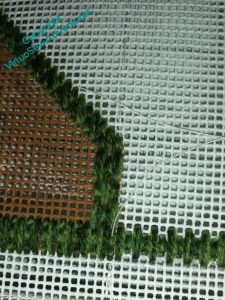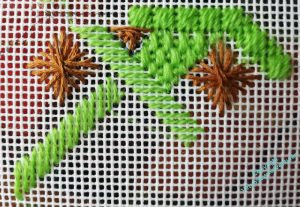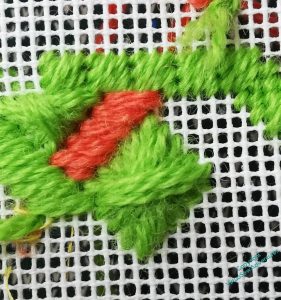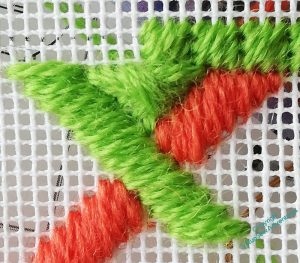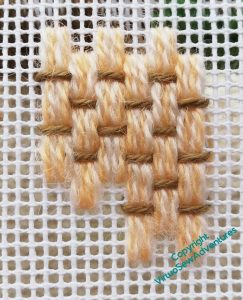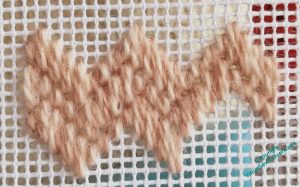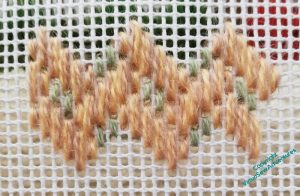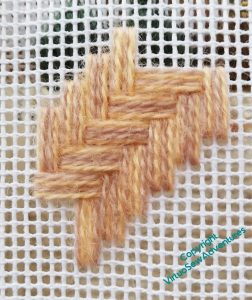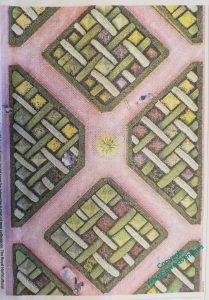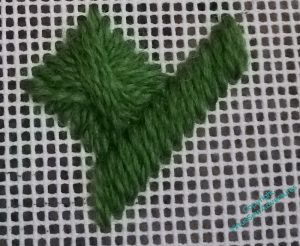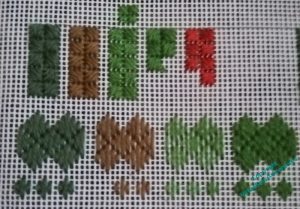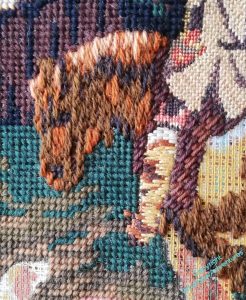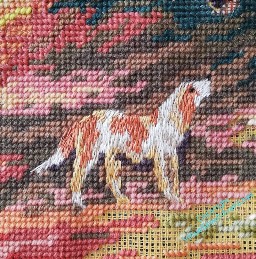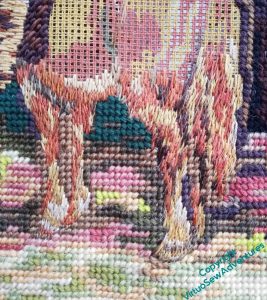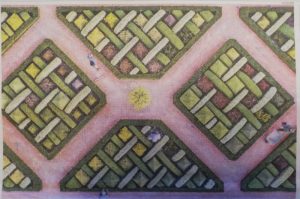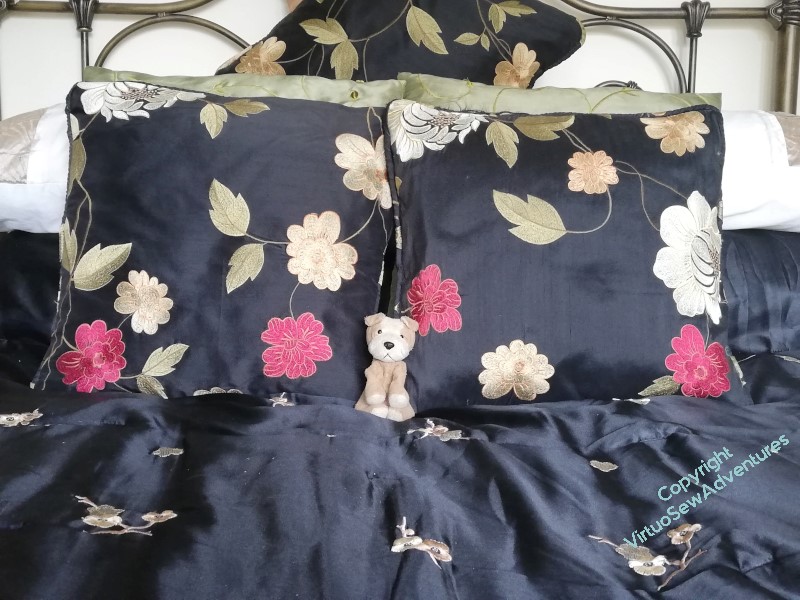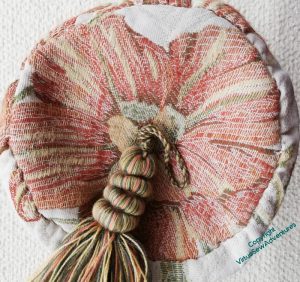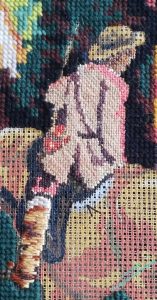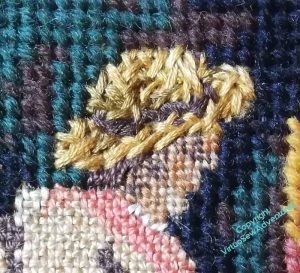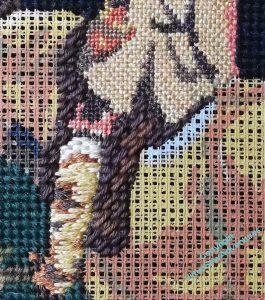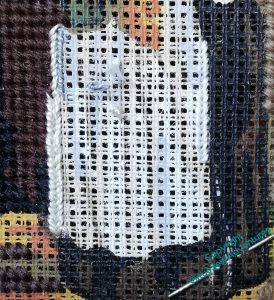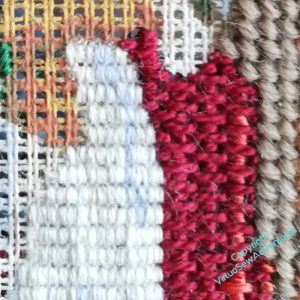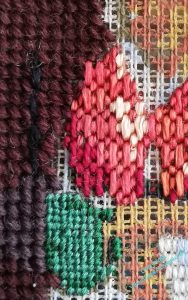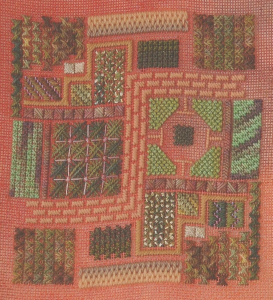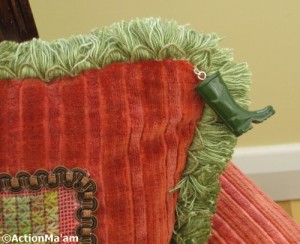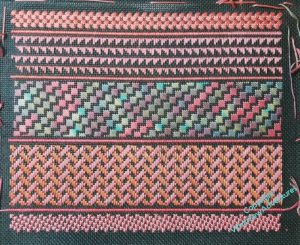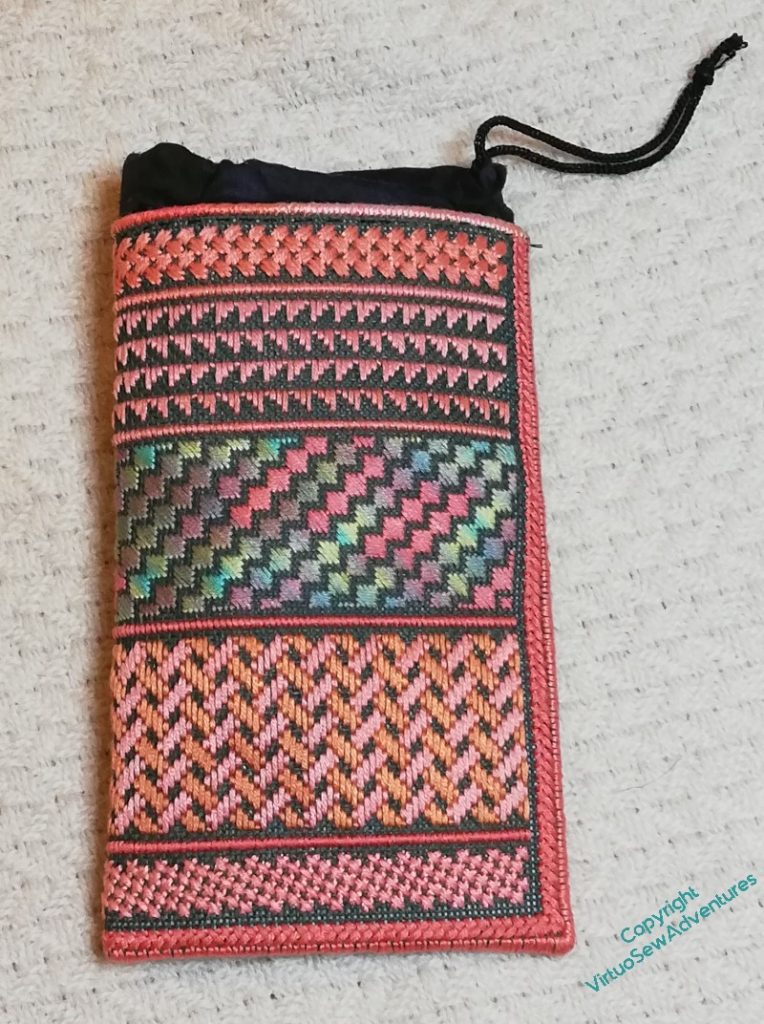Category: Needlepoint
Beginning The Knot Garden
A “Site Visit” recently gave me the chance to look at my wools in the room for which the cushion is destined, and to talk to my cousin about the whole thing. It also provided a reminder of the truism that, no matter how extensive the stash, for any particular project, the stash will prove inadequate!
I had my experimental panel with me, and one of the things my cousin said was that she was not particularly taken with the effect of the tent stitches or straight stitches infilling between the pattern stitches. I agreed that it looked a bit clunky and congested, so when I got home again, I got out my acrylic paints and painted the canvas, just the area of the borders.
What I have done is to use three different shades of brown, solo and in mixtures. And I’ve painted both sides of the canvas, to make the coverage a bit more thorough. This way, I’m not trying to produce an absolutely flat colour, as though the canvas were dyed or coloured from the start.
You can also see in this picture that the “pathways” spill out into the surrounding canvas. I was intending the stitching to do so as well, but there’s an old saying in military circles, that “No plan survives contact with the enemy”. I would adapt that for stitchers – I don’t regard the canvas as my enemy, but no plan survives the first stitching session unchanged!
I started to work the Parisian Stitch border around the beds, using two different colours of crewel wool in the needle, and soon decided that although I want to have a couple of rows of tent stitch around the outside, to help with adding the back to the cushion, I also want the pattern area properly delimited. So the line between the beds will be filled with a line of Parisian stitch as well.
Testing, Testing (phase 3)
There is still much to play with, with regards to the the stitching for the Knot Garden Parterre.
At this point, I’m trying to balance accurate impressions – and therefore useful testing – with not tearing my thread to pieces or wasting any of it. At present I am still thinking of doing this out of stash, if possible, which is why I’m using an impossibly bright shade of green here – I’m unlikely to want it in the real thing!
Now, you see here that the short Parisian Stitch enticed me into a broader strap than I was intending, and it has unbalanced the Mosaic Stitch of the border, which in turn became Scotch Stitch as it turned into the diagonal, and lost the pattern it had.
Here, by contrast, I have demonstrated one of the other hazards of canvaswork, especially for my astigmatic eyes – I’ve suddenly managed to turn a Diagonal Rhodes Stitch into a slightly oblong and twisted diagonal Rhodes stitch. I didn’t see it happening, so I am going to have to guard against it with some care.
I think I need to make my stitches and straps bigger, too: the shape drawn on the canvas is the size of one of the ones on the finished piece, and I started the outer border on the centreline, and turned onto the diagonal at the appropriate point. The first horizontal row of diamonds should have two in it. Two properly square diamonds, that is!
And here you see the challenge I need to address: the diagonal Rhodes Stitches start with a horizontal or vertical stitch, so what I need in the angle between the straps is a gap (as you see top and bottom of this intersection) and not a thread (as you see left and right)
At this point I’ve been stitching and unstitching so often that I have lost count of myself, and keep on losing track of the stitch lengths I intend, so there will be a pause to regroup!
Testing, Testing (phase 2)
I’ve been playing around with possible stitches for the pathway in the Knot Garden. In the source picture, it looks to be made of bricks laid in a pattern, rather like a parquet floor.
I don’t feel I’m obliged to replicate that pattern, but this one on the left is altogether too square, and won’t help the sense of movement I’m going to need to counterbalance the borders, which I rather expect to be rather static, given all the Diagonal Rhodes Stitch that’s going to be happening.
The one on the right is the same Medieval Mosaic Stitch from Jo Ippolito Christensen that I used, voided, in the sunglasses case, but this time worked exactly as diagrammed. I like it, and it’s easy enough to work, but I don’t think it does the job I will be asking it to. I’m sure I will work it for real one day, but not for this project!
When I replaced the stitches that were voided in the sunglasses case with stitches in a different colour and thread, to point up the woven pattern, I got something a lot more hopeful…
I like this one a lot. Although I must admit it does rather recall the diaperwork you sometimes see on Tudor buildings, so maybe not very floor-like!
And then I found another, one that actually looks a lot like herringbone brickwork without any adaptation.
I like this one a lot, too.
I will have to see which of these presents itself most strongly when I’ve got more of the ideas crystallised.
Testing, Testing… (phase one)
Remember this, the Knot Garden parterre?
It’s going to require a little more precision and therefore a little more planning than I usually indulge in. So there’s also going to be a bit more experimentation than usual. I might not go to the length of actually charting the finished piece, but I’m certainly intending to have a very clear idea of what is going where, and what thread or threads I’m going to use.
I’ve been intrigued to note that, from pulling out a huge variety of threads to use, an assortment of fibres and an assortment of colours, I’m beginning to restrict my ideas to a much smaller palette of threads and stitches.
As I looked at the picture more closely, it became clear that the squares within the beds were topiary pyramids. Maybe some are suffering from box blight, hence the colour variations, but this gave me a good place to start experimenting. I’ve gone to the trouble of framing up a piece of the canvas I’m going to use, so as to experiment properly, and my first observation is that I am going to need to be on top form when I work this, because it’s dreadfully easy to go adrift!
However, I think it’s fair to say that Diagonal Rhodes Stitch makes a fine pyramid in topiary! The straight stitches are in the same colour, which they won’t be, but I think the stitch length, compared with the Rhodes Stitch, looks about right for the width of the little hedges that create the strapwork effect.
I’ve also been testing out other threads and stitches – tapestry wool, soft embroidery cotton, stranded cotton. I want to have varying textures and patterns within the strapwork, creating a nice harmonious whole – but a stitched harmonious whole. I could easily chart – or even freehand – a tent stitch reproduction of the picture, but it wouldn’t have the personality needed for the place it’s going to live. Textured stitches will help to create that personality.
A second conversation
You may recall that I started on the horse in the canvaswork, and then suffered from Doubts. I thought it looked an unholy mess, and diverted my thoughts to the fence by the cottage. Which turned out very pleasingly, which is always a relief.
Then my cousin made a passing comment that helped me unstick the problem – she said that there are two conversations going on in the picture, one between the man and the woman, the other between the dog and the horse. That being the case, it seemed to me that I should maybe use the same technique for the dog and the horse, even the same sort of thread, so as to highlight the conversation.
I wanted to create the impression of fur, but nothing too shaggy, so while I wrestled with unpicking the horse, I started on the dog. Stranded cotton, separated and recombined using several close colours (I have a lot of stranded cotton, so this is all still stash), and then worked upward from the feet and the end of the tail in something a bit like long and short stitch.
I think this has worked well. We have friends whose dog is a similar shape and colouring to this one, and it was fun to sit and stitch with her in mind.
Of course, an entire horse (I’m calling him “Dobbin”, of course!) is going to take some time to do, since I need to work upwards. But at least I’ve made a good start here, smaller stitches around the hoof, longer stitches, with still longer ones planned, for the tail.
He’s a rough-coated working country horse, not a sleek and shining racehorse, so if the colours are clouded a bit, and the darks and lights not as distinct as they might be, that’s all to the good.
I’ve continued to work on the tent stitch, too, every which way, as it is in the sections already worked when I got the canvas, so the whole thing is getting closer to being finished..
A Site Visit
The next canvaswork project, commissioned by my cousin, has had a slight change of direction. It is still based upon this drone shot, but it is to be full coverage rather than voided stitches, and it’s going to sit on her bed, worked in colours from the curtains, to pull those colours onto the bed.
So when I went to visit a few weeks ago, I did a site visit – as shown here, including the Hound of the Doleful Countenance, for scale. We’ve decide that the final cushion is to be a rather Biblical cubit in length (that is, forearm from elbow to fingertips), which will go from the middle of one black cushion to the middle of the other, and at least a handspan high.
I’ve also brought home the cover for the doorstop, in the fabric I need to reflect in my thread choices – which means, not only did I not have such a weight to bring home, but my cousin also still has her doorstop!
My next job is to draft out the pattern to transfer to the canvas. Once upon a time, I had canvaswork design software, and I might have tried to chart a design first, but it didn’t include some of the stitches I might want to use, and with so many of the more unusual threads in my view, I will be doing a lot of experimenting along the way!
The Rider
When I first started looking at this canvas, I was reminded of the episode of “A Stitch in Time” in which Ninya Mikhaila did a reconstruction of the garment in a portrait of a hedgecutter on a country estate. The garment in question was made of leather or buckskin and very plainly at least 50 years behind the fashion at the point at which it appeared in the photo. So it had been made for the Squire, and then gradually been passed from hand to hand, appearing to be almost indestructible, if not as good looking as before. So my first thought was to use soft cotton. However, I don’t have much soft cotton in my stash, and it turned out too heavy for the canvas anyway, so I used pearl cottons and Caron Collection “Watercolours” thread, one strand of the three. Linen stitch is what basketweave tent stitch looks like on the back, and although it can be a bit tricky to do, and it’s more time-consuming than basketweave tent, it’s worth the effort!
As with the lady at the cottage door, I blended several different shades of stranded cotton to create the approximate shades for the face, and used petit point to bring in a little more detail.
The hat was a bit more of a challenge, but in the end I decided it was a woven straw hat rather than a felt one, and created a criss-crossing effect, with something like herringbone stitch, but worked in a rather freestyle fashion.
The pouch hanging at his waist is stranded cotton, tiny cross stitches using the single crossing points of the canvas, and I decided to make his breeches in Kelim stitch, hoping it would make a sort of corduroy effect.
Not really, as it turns out, but it was worth a try!
The saddle is soft cotton, and I’ve used condensed mosaic stitch. I want the level of shine to contrast with the horse, which is probably going to be in Paterna.
Getting going on that canvaswork picture
One of the nice things about the double thread canvases commonly used for painted canvas designs is that you can decide to go right off-piste with them, separate the threads, and use stitches at a different scale.
I’m going to do that with the characters – the woman, the horse and his rider, and the dog – on this piece, because in that way I will be able to use stash threads, and enjoy exploring the highways and byways of ornamental canvaswork stitchery. It may well unbalance the finished piece, so I may not regard it as a success when complete, but I will have had fun along the way!
This, however, was a false start. The stitch is Kelim stitch, or something like that, and the threads are pearl cottons. I was aiming for something that would look a little like a sturdy linen twill, but this didn’t seem to me to be the right choice after all.
One of the disadvantages of going down to petit point scale is that unpicking is a real nightmare. Not fun at all. <shudders dramatically>
I’m much happier with this. I’ve used trammed Gobelins stitch for the apron, and found a use for the dreadful lifeless slubby linen thread that DMC brought out – 20 years ago now? – which I bought because it looked interesting and have found a heartbreaking material to use every time I’ve tried. In this context, it worked very much better than I expected. There’s no shine, so it looks like a heavy, sturdy fabric, and the colour variations, much subtler than if I’d used the designated wool colours, recall the appearance of a crumpled linen fabric, its crisp white knocked back by dust and grime.
The skirt is a combination of a rather gorgeous rayon filament for the lighter sections with a pearl cotton for the darker ones, and I’ve turned Parisian Stitch from vertical to horizontal to help me to create contrasts with the shawl the woman has around her shoulders.
The shawl is in Parisian Stripe Stitch (there’s an extra row of small vertical stitches, which keeps the long stitches in alignment).
I may have ended up with not quite the right shade of green for the vessel the woman is holding. Something about it reminded me of the bright green glazed fragments that used to come out of trenches on Time Team, of happy memory, so I decided to go with the colour, and maybe adjust later when I have everything else in place. I’ve done my best to add a little shape and shading, but in due course I may stitch over this in curving long-&-short stitches. It’s straightforward Madeira stranded cotton, and I know I’ve not finished the skein!
And in other news, Episode 75 of SlowTV Stitchery is now live. In which we discuss the felt “coloured sketch” of the Dig House, John Pendlebury, the obstreperousness of William Marshall, and look ahead to finishing the Amarna Family Group.
Another new project to think about
Remember this? It was an exploration of canvaswork, a very long time ago, and when I’d finished it, I hadn’t the vaguest idea what to do with it. Then my cousin said she knew exactly what to do with it, and could she have it, please?
She and her local soft furnishing people turned it into a rather fabulous cushion, and it has been sitting happily kicking welly-booted heels in the air on a chair in her conservatory ever since.
Fast forward to some recent reorganising in her house, and she has a another chair that might be interested in a companion piece. Not the same shape, and not the same canvas, fortunately, and not necessarily the same colours either, just similar. I have to find the canvas before I can get excited about this one, so it will be a while, but I do have something to think about.
My cousin found a gorgeous drone shot of a knot garden in a National Trust property, and said “Start from this!”. The central tree might even end up as a sculpted piece of one of the pile stitches – that would be fun, wouldn’t it!
I’m thinking I might choose to use a brown canvas this time, and use as many variegated greens as I can lay my hands on. But as I’m not sure where I’ll find the canvas, my ideas have plenty of time in which to change….
Finishing my canvaswork sunglasses case
So in due course I had finished the coral canvaswork panel, and took it off the frame. Then I had a slight anxiety about the size, and whether there would be space to go all around the sunglasses, and went around three sides with herringbone stitch.
The herringbone stitch rather emphasised the unevenness of one of the sides, but I’m choosing not to mind that, especially as the herringbone stitch had a secondary task; that of attaching some padding fabric to the the back of the canvaswork.
The fourth side was also herringbone stitch, but in that case, it’s the herringbone edging I often use on canvaswork pieces to cover and strengthen edges.
The finished piece was just folded in half and satin stitched to join the edges together. I didn’t herringbone it in this case because it was becoming so very difficult to stitch!
Finally, I took one of those flimsy black fabric cases that you sometimes get with a pair of sunglasses, and stitched it in around the top edge. Lovely though it is to have a bright, strong case for sunglasses, it’s not remotely protective if they keep falling out, and the drawstring will ensure that they stay put.
Now all I need is sunglasses weather!

